
Regular Infantry in Semirechye
The Siberian Whites sent some regular infantry in August 1918 and two regiments spent the entire war on the Semirechye front.
5th Siberian Rifle Division
There is no direct information on the uniform of this regiment. However, as a "rifle" division it had Imperial practice as a guide, apart from some known deviations for White Siberia.
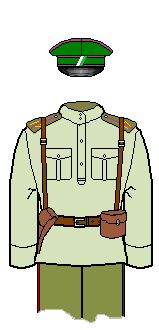 |
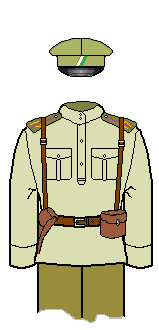 |
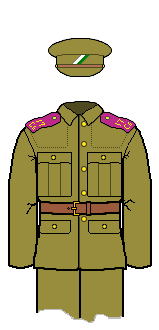 |
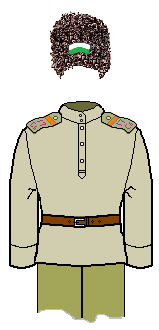 |
| Officer: parade dress | Officer: field dress | Trooper: parade dress British uniform | Sergeant-Major: field dress |
The uniform was plain khaki, except that trousers were meant to have a thin raspberry stripe and caps piping even in the khaki field versions. It it likely that any suitable khaki was worn in practice. English uniforms and Japanese overcoats certainly made it to Semirechye, so were likely worn.
Bergenschild.ru has uniforms for the units on either side of the 5th Division in numerical order:
the 21st Rifle Regiment uniform follows the basic pattern, and so did the 16th Ishim Rifle Regiment uniform until it got special colours. These show old rifle practice being kept for the most part (but note that these show the colour "raspberry" as red, which it quite likely was in practice).
Uniform Details
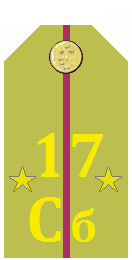 |
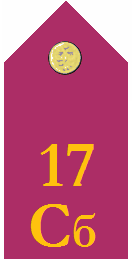 |
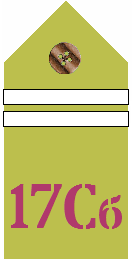 |
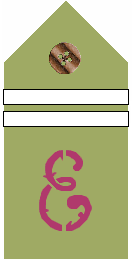 |
| 2nd Lieutenant marked on khaki side | Private, dress version | Corporal, field version | Corporal, Eger (Jäger) Battalion |
Coloured shoulderboards were meant to be in raspberry, with markings stencilled in yellow. Khaki side had markings in raspberry. Buttons were gold. The cipher was the unit number plus "Сб." for Siberia.
Formally, the officer lace, monogram and rank markings were in gold. However shortages in Siberia meant that many were marked on the khaki face, with yellow cipher (standing for the gold) and the lines between braid drawn in raspberry.
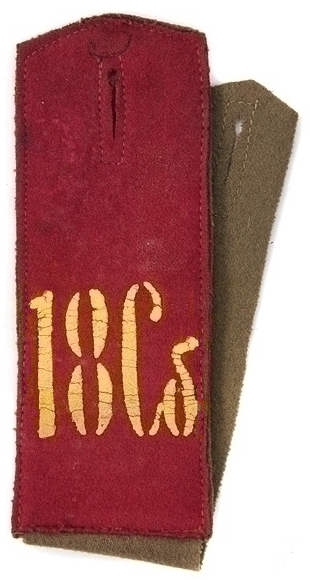 In practice it was very difficult to obtain proper raspberry, so actual shoulderboards were probably marked in whatever range of reds could be obtained.
In practice it was very difficult to obtain proper raspberry, so actual shoulderboards were probably marked in whatever range of reds could be obtained.
Unit cockades started with the white over green cloth of Independent Siberia. In early 1919 this was changed to metal cockades, on the Imperial model. However since these were not available in any numbers, many units instead used white-blue-red strips instead. As the 17th Regiment was an early Siberian unit, and a long way from the inspectors in Omsk, we have assumed that they kept the white-green throughout.
Fur hats could have raspberry cloth, with gold braid cross for officers. More likely most were plain khaki.
Attached to the division by 1920 was a Jäger Battalion, which was normal practice for Siberian divisions. The schemes at Bergenschild show the standard curly "E" for Егер, but oddly without the "5" that one would expect to indicate the division.
History in the RCW
The division briefly started life as the 5th Steppe Regiment. In August 1918 it became the 5th Siberian Division and its components the 17th Semipalatinsk, 18th Tobol, 19th Petropavlovsk and 20th Tyumen Regiments and 5th Siberian Artillery Divizion. It was sent to fight on the Semirechye front.
The 18th and 20th Regiments were detached to the 7th Tobolsk Siberian Division in January 1919, and sent to the 3rd Steppe Army Corps (they were likely never fully combat ready though). The 17th and 19th Regiments fought on in the Semirechye area until evacuation to China in March 1920.
In 1920 the Jäger Battalion is noted as having 361 soldiers, 14 officers and 6 machine guns.
An Engineer Divizion mutinied and defected to the Red in February 1920 with just over 600 people.
Flags
As new units they had no Imperial practice to fall back on. Sister regiments seem to have mostly gone for variations on the white and green of Siberia. This is one known design:
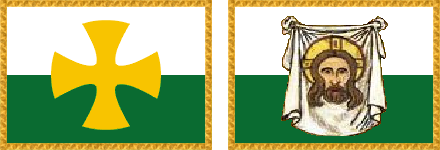
There is a reference to the 18th Tobolsk Regiment having a red flag with a wide yellow border and an orthodox cross with "Сим Победиши" on the front.

Other Similar Units
This uniform is basically that of any White rifle regiment in the east.